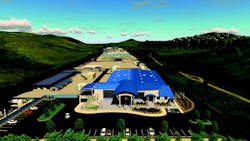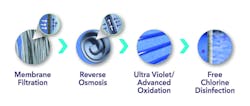Building a legacy of water innovation takes years of planning, determination, leadership, partnerships — and funding. These elements have coalesced in East San Diego County, Calif., for an innovative and collaborative water reuse project.
Scheduled to be complete in 2025, the East County Advanced Water Purification Program (East County AWP) will create a new, local, sustainable and drought-proof potable water supply using state-of-the-art technology to purify the area’s recycled water. The program will generate up to 11.5 million gallons per day (MGD) of new water — meeting approximately 30 percent of current drinking water demands for East San Diego County residents.
Most recently, the program was awarded a $388 million Water Infrastructure Finance and Innovation Act (WIFIA) loan from the U.S. Environmental Protection Agency (EPA). The East County AWP program is the result of many years of strategic, long-term planning and the WIFIA loan marks a historic milestone in its development.
“Water infrastructure is one of the best investments we can make to improve public health and the environment, create jobs, and address pressing challenges that face our communities,” said EPA’s Principal Deputy Assistant Administrator for Water, Radhika Fox. “EPA is proud to partner on this project, which uses proven technology to bolster drinking water supplies in this climate-stressed region.”
The Impetus of Change and Partnerships
Imported water rates have been on the rise for decades and with drought and capital improvements necessary for aging infrastructure, costs for imported water and wastewater treatment are expected to continue to increase over the long term.
To counter looming water and wastewater rate increases, the East County AWP program was born. The program was initiated by the Padre Dam Municipal Water District and developed into the partnership between the four agencies providing potable water and/or wastewater services.
In November 2019, the agencies formed a Joint Powers Authority (JPA) to own, administer and operate the program. The JPA includes Padre Dam Municipal Water District (Padre Dam), the County of San Diego (County) and the City of El Cajon (El Cajon). Helix Water District (Helix) also joined the partnership from the water side and has a non-voting, Ex-Officio Board member seat on the JPA Board.
This partnership is based on dedication, innovation and collaboration and is seen as a model for other cities and municipalities across the nation and the globe. Together, the partners combine wastewater supplies and water treatment/distribution resources to achieve the ultimate goal of providing local water reliability and wastewater treatment at a cost that is competitive with alternative imported water and wastewater treatment rates.
“The East County Advanced Water Purification Program is unique and forward thinking in so many ways,” East County Chair and City of El Cajon Councilmember Steve Goble said. “One reason in particular is the unprecedented collaboration of four East San Diego County entities which have come together with the common goal of water reliability at a competitive cost.”
Benefits Are Immense — Financial Feasibility is Crucial
The program is in the design phase, with a current project cost of approximately $640 million. Financial feasibility and ratepayer affordability is a major go/no-go factor for the JPA and East County constituents, as well as environmental/regulatory compliance and public perception. Community support and understanding is a key factor of the project, with videos, website, tours, materials and educational events offered and available to highlight the numerous benefits of the program.
With the topic of program funding front and center to decision-makers, great efforts have been made to identify and secure grants and other funding opportunities. The $388 million-dollar WIFIA long-term, low-interest loan awarded by the EPA was the most recently secured funding. Previously, $131 million was secured through various federal, state and water agency grant and incentive programs. A $101 million low-interest loan through the State Revolving Clean Water Fund was also obtained and $86 million in funds from the Metropolitan Water District’s Local Resources Program was secured.
Without the WIFIA loan and the other funding, the program would only be an ingenious dream and nothing more. The grants, low-interest loans and other funding make the program possible and are a crucial investment in the future. Project planning, design, construction and facility operations are expected to create 2,500 jobs but it is the long-term local water supply and increased cost control that highlight the win of the program for East San Diego County. The JPA has kept cost considerations at the forefront of decisions for the program from the beginning and continues to keep ratepayers’ interest top of mind.
Purification Process and Benefits
The project will capture 15 MGD of wastewater generated by Padre Dam, County and El Cajon customers. The wastewater will be treated to tertiary standards and then undergo advanced water purification, which includes membrane filtration, reverse osmosis, advanced oxidation and free chlorine at a new Advanced Water Treatment Facility.
Padre Dam, a provider of water and wastewater services, is located near the nexus of a wastewater pipeline, which collects wastewater from its own customers (4 MGD) as well as the County of San Diego (4 MGD) and City of El Cajon (7 MGD). This pipeline currently travels 20 miles to the coast, where the wastewater is treated by the City of San Diego and discharged into the Pacific Ocean. The cost of City of San Diego’s wastewater treatment is passed on to the customers of the above three entities.
The program will eliminate the need to send most of East County’s wastewater to the City of San Diego’s Point Loma Wastewater Treatment Plant for ocean discharge.
In addition to purchasing and distributing potable water and providing wastewater services, Padre Dam has been recycling its own wastewater since the late 1950s and currently operates a facility that treats and produces 2 MGD of tertiary recycled water for non-potable reuse in portions of the community as well as Santee Lakes, a local recreational preserve.
Water costs are an important sensitivity to all partner agencies. Upon completion, the area’s water and wastewater costs are expected to be cost-competitive with imported water costs and wastewater treatment costs and in the long-term, saving ratepayers significantly from the status quo approach. The program is an excellent example of local government agencies collaborating to find an innovative solution for the communities they serve. WW
About the Author: Kyle Swanson is the director of advanced water purification, providing leadership and guidance in the design and implementation of the East County Advanced Water Purification Project. He has over 20 years of experience in water related industries and is a licensed distribution and treatment operator and certified public manager.





